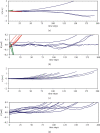Learning Intuitive Physics and One-Shot Imitation Using State-Action-Prediction Self-Organizing Maps
- PMID: 34804145
- PMCID: PMC8604601
- DOI: 10.1155/2021/5590445
Learning Intuitive Physics and One-Shot Imitation Using State-Action-Prediction Self-Organizing Maps
Abstract
Human learning and intelligence work differently from the supervised pattern recognition approach adopted in most deep learning architectures. Humans seem to learn rich representations by exploration and imitation, build causal models of the world, and use both to flexibly solve new tasks. We suggest a simple but effective unsupervised model which develops such characteristics. The agent learns to represent the dynamical physical properties of its environment by intrinsically motivated exploration and performs inference on this representation to reach goals. For this, a set of self-organizing maps which represent state-action pairs is combined with a causal model for sequence prediction. The proposed system is evaluated in the cartpole environment. After an initial phase of playful exploration, the agent can execute kinematic simulations of the environment's future and use those for action planning. We demonstrate its performance on a set of several related, but different one-shot imitation tasks, which the agent flexibly solves in an active inference style.
Copyright © 2021 Martin Stetter and Elmar W. Lang.
Conflict of interest statement
The authors declare that there are no conflicts of interest regarding the publication of this study.
Figures





Similar articles
-
A Bayesian Developmental Approach to Robotic Goal-Based Imitation Learning.PLoS One. 2015 Nov 4;10(11):e0141965. doi: 10.1371/journal.pone.0141965. eCollection 2015. PLoS One. 2015. PMID: 26536366 Free PMC article.
-
An active inference model of hierarchical action understanding, learning and imitation.Phys Life Rev. 2023 Sep;46:92-118. doi: 10.1016/j.plrev.2023.05.012. Epub 2023 Jun 5. Phys Life Rev. 2023. PMID: 37354642 Review.
-
Physical reasoning is the missing link between action goals and kinematics: A comment on "An active inference model of hierarchical action understanding, learning, and imitation" by Proietti et al.Phys Life Rev. 2024 Mar;48:198-200. doi: 10.1016/j.plrev.2023.08.017. Epub 2023 Sep 1. Phys Life Rev. 2024. PMID: 38350304 No abstract available.
-
Imitation and mirror systems in robots through Deep Modality Blending Networks.Neural Netw. 2022 Feb;146:22-35. doi: 10.1016/j.neunet.2021.11.004. Epub 2021 Nov 16. Neural Netw. 2022. PMID: 34839090
-
How can the study of action kinematics inform our understanding of human social interaction?Neuropsychologia. 2017 Oct;105:101-110. doi: 10.1016/j.neuropsychologia.2017.01.018. Epub 2017 Jan 21. Neuropsychologia. 2017. PMID: 28119002 Review.
References
-
- Goodfellow I. J., Bengio Y., Courville A. Deep Learning . Cambridge, MA, USA: MIT Press; 2016.
-
- Krizhevsky A., Sutskever I., Hinton G. E. ImageNet: classification with deep convolutional neural networks. In: Pereira F., Burges C. J. C., Bottou L., Weinberger K. Q., editors. Advances in Neural Information Processing Systems 25 . New York, NY, USA: Curran Associates, Inc.; 2012. pp. 1097–1105.
-
- Graves A., Eck D., Beringer N., Schmidhuber J. Biologically plausible speech recognition with LSTM neural nets. In: Ijspeert A. J., Murata M., Wakamiya N., editors. Biologically Inspired Approaches to Advanced Information Technology . Berlin, Heidelberg: Springer Berlin Heidelberg; 2004. pp. 127–136. - DOI
-
- Graves A., Mohamed Ar, Hinton G. E. Speech recognition with deep recurrent neural networks. 2013.
MeSH terms
LinkOut - more resources
Full Text Sources

